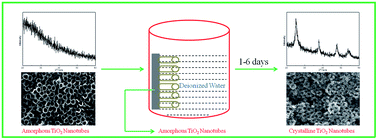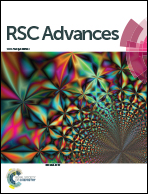Water assisted crystallization, gas sensing and photo-electrochemical properties of electrochemically synthesized TiO2 nanotube arrays†
Abstract
We report a simple water assisted crystallization process for electrochemically synthesized TiO2 nanotube (TNT) arrays at room temperature (30 °C) and near-room temperature (50 °C). The TNT array samples kept immersed in de-ionized water at room temperature for durations from 1 day to 6 days show a distinct anatase phase confirmed by both X-ray diffraction and transmission electron microscopy. When the process is repeated at an elevated temperature of 50 °C, the crystallization is accelerated with the appearance of an anatase phase within 8 h of treatment. Interestingly, addition of 0.05 M HCl or HNO3 to the DI water during treatment helped in forming the rutile phase of TiO2, along with the dominant anatase phase. By carefully choosing the nanotube parameters (length and diameter) it has been possible to retain the nano-tubular morphology, which is advantageous for applications such as solar cells and gas sensing. Finally, we show the gas sensing and photo-electrochemical characteristics of the DI water crystallized TNT arrays. The samples show good sensitivity and appreciable values of photo-current under the given experimental conditions.


 Please wait while we load your content...
Please wait while we load your content...